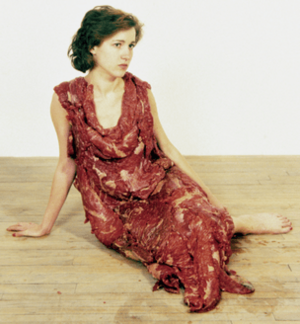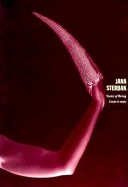Vanitas: Flesh Dress for an Albino Anorectic facts for kids
Vanitas: Flesh Dress for an Albino Anorectic is a famous artwork from 1987. It was created by a Canadian artist named Jana Sterbak. This unique artwork first appeared in Montreal. Later, it became very well-known when it was shown at the National Gallery of Canada in Ottawa. The artwork is a dress made from about 50 pounds of raw flank steak. It is sewn together and hung on a hanger. The artist said the work shows the difference between being proud of how you look (vanity) and how bodies naturally change over time. Copies of this artwork are kept at the Walker Art Center in Minneapolis and the Centre Pompidou in Paris.
Contents
What is the Flesh Dress?
How the Artwork Looks
The artwork is called the "Flesh Dress." It is made from pieces of beef sewn together. The dress hangs on a special display stand, like a tailor's dummy. It is a long, sleeveless dress that reaches to the calves. The bottom edge looks rough and jagged. You can clearly see the patterns of the steak and the thick fat. This gives the dress a strong, almost bloody, look.
The Dress and Its Changes
The dress is made from about 50 to 60 pounds of raw flank steak. It has to be made new each time it is shown. When it is first put on display, the steak is fresh and bright red. Over time, it slowly changes color to beige and then brown. The dress also changes its shape and size as it dries. In 1991, the meat for the dress cost about $260 or $300.
Meaning Behind the Art
The title of the artwork, "Vanitas," gives us a clue about its meaning. "Vanitas" is a type of art that shows death and how things decay. This artwork uses unusual materials, which was a popular trend in art during the 20th century. It makes people think about what is normal and what is strange. It challenges how we usually understand things.
Other Meat-Inspired Art
Jana Sterbak was not the first artist to use meat as clothing.
- In 1939, artist Salvador Dalí showed seafood outfits at an event called The Dream of Venus. These outfits included a bikini made of lobster.
- In 1983, the music band The Undertones had an album cover called All Wrapped Up. It showed a model wearing cuts of meat held in place with plastic wrap. This outfit mostly used bacon and had a sausage necklace.
- In 2010, singer Lady Gaga wore a meat dress to an awards show. Her dress was similar in style to Jana Sterbak's artwork.
Where the Flesh Dress Was Shown
Early Displays
The Flesh Dress was first shown in 1987. This was at a gallery in Montreal called Galerie Rene Blouin. At that time, the artwork did not get much attention.
National Gallery of Canada Show
In 1991, when Jana Sterbak was 36, the National Gallery of Canada in Ottawa held a special show of her works. It was called "States of Being." This show looked back at her art from the past ten years. The exhibit ran from March 8 to May 21, 1991. It included other works like "Cone on Hand" from 1979. Many people came to see the show, partly because of the discussions around the Flesh Dress. A book called Jana Sterbak: States of Being = corps à corps also talked about the exhibit.
Replacing the Meat
As the meat on the dress dried out and started to fall off, someone gave the gallery $260 to buy new meat. There was some talk about the exact cost, with one magazine saying it was $350. Because the artwork had received a lot of public attention, the gallery staff had to pretend they were caterers when they looked for a butcher in Ottawa. They did this to get the replacement meat without causing more fuss.
Other Exhibitions
In 1993, the Walker Art Center in Minnesota bought a copy of the artwork. A small team rebuilt it in 2011 for a show called "Midnight Party." The Flesh Dress was also shown at the Tate Modern in London for an exhibit called "Rites of Passage." Later, a smaller show of Sterbak's work went to the Antoni Tàpies Foundation in Barcelona. For that show, the artist herself decided to remove the dress from the display. In 2011, the artwork was shown at "Tous Cannibales" at la Maison Rouge. It was also part of the Elles@Centre Pompidou exhibit in Paris in 2010.



